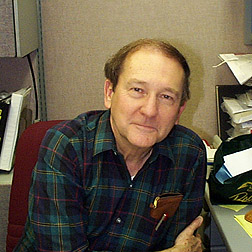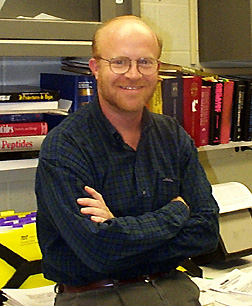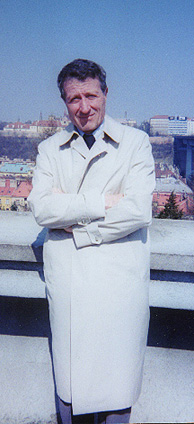
| T H E N I H C A T A L Y S T | N O V E M B E R – D E C E M B E R 2000 |
|
|
|
EUREKA! AND BEYOND:
HARD LESSONS IN TECH TRANSFER
Judging from the experiences of a panel of NIH intramural investigators speaking at the Research Festival in October, tech transfer can be a long journey, a short glide, or an uphill battle after the first heady thrill of discovery.
At the October 12th minisymposium, the Office of Technology Transfer (OTT) presented a panel of scientists whose bright ideas (Eureka!) turned into commercial products and cash for the investigators, the labs, and the federal piggy bank. According to OTT, more than 1,200 licensing agreements have been signed since 1993. A 1998 General Accounting Office (GAO) report on the technology transfer activities of six major U.S. government agencies stated that, since 1996, NIH has generated 95 percent of the total royalties received ($102 million) by the federal government.
 |
|
Robert
Purcell
|
Serendipity
in Science:
The
Hepatitis A Vaccine
Robert Purcell, chief of the Hepatitis Viruses Section in NIAID’s Laboratory of Infectious Diseases (LID), opened the symposium. His tale, spanning nearly 20 years, began with discovery of the hepatitis A virus (HAV) in 1973 by postdoc Steve Feinstone, now with FDA’s CBER. Using immune-electron microscopic techniques developed by LID’s Albert Kapikian to visualize transmissible gastroenteritis, Feinstone was able to see HAV structure and went on to develop a diagnostic test for hepatitis A. He also obtained 20 serum samples from another study on post-transfusion hepatitis at NIH and, with his colleagues in the LID and Harvey Alter (see "Alter Takes a Lasker") in the CC Blood Bank, discovered non-A, non-B hepatitis (hepatitis C).
Despite the breakthroughs in visualization and diagnosis, isolation of the virus and production in culture (the first steps toward preparation of a vaccine) proved fruitless. Then, serendipity played a hand. In 1976, Ian Gust, an Australian PI on sabbatical in Purcell’s lab, moved the lab closer to success when he brought in stool samples he had collected from a family in Australia that had developed hepatitis A from eating raw mussels.
The strain of HAV recovered from the family’s stools, dubbed hepatitis A virus strain HM175, turned out to be critical to the subsequent development of the vaccine because in 1981 Richard Daemer, also now at CBER, isolated the HM175 strain of HAV and was able to grow it in cell culture. Purcell’s team was then able, by serial passage in cell culture, to generate a live attenuated virus, which could be tested in nonhuman primates for development of vaccine in humans.
At this point, Purcell and co-workers sought a potential commercial partner to develop a live attenuated hepatitis A vaccine and settled on SmithKline Beecham. In a collaborative effort by Purcell’s group, the Walter Reed Army Institute of Research, and SmithKline Beecham, the HM175 strain of HAV was adapted to grow in a cell type suitable for vaccine development (MRC-5 cells). By then, however, SmithKline Beecham was more interested in developing an inactivated vaccine and was working closely with a strain of HAV provided by scientists in Switzerland. Purcell asked SmithKline Beecham if it would compare the HM175 strain with the Swiss strain for suitability as an inactivated vaccine. SKB agreed and found that the HM175 strain was a better inactivated vaccine candidate than the Swiss HAV. They subsequently dropped the Swiss option and pursued an inactivated vaccine with the HM175 strain in collaboration with Purcell’s group.
Over the next decade, members of Purcell’s lab cloned and sequenced wild-type and attenuated HAV strain HM175 and mapped the location of mutations important for allowing the virus to grow in cell culture and that attenuated virulence.
In all, the researchers in Purcell’s lab have applied for more than 60 patents and have secured 21, 10 of which relate to the hepatitis A vaccine; some of these are held jointly with SmithKline Beecham.
In 1991, the HM175 strain of HAV became the first licensed hepatitis A vaccine (licensed first in Switzerland), and it was licensed in 1995 in the United States. It is currently one of two licensed hepatitis A vaccines in the United States (the other is manufactured by Merck Laboratories).
Despite the challenges and potholes on the road to discovery, this line of research, Purcell concluded with a smile, "has been very good to the lab, which," he added, "is now pursuing hepatitis C and E vaccines."
 |
|
Frank
Robey
|
The Thioether Linkage: Connecting Peptide Chemistry with Industry
Frank Robey, an NIDCR senior investigator, described the novel chemical process that he and colleagues Wolfgang Lindner and Ray Fields invented and that others have brought to bear in such clinical uses as detecting acute deep vein thrombi and diagnosing and treating non-small-cell lung cancer.
Robey, a chemist whose focus is AIDS vaccine research and immunology, developed an "enabling" technology—one that can be used in many diverse applications, often to speed up product design. In 1986, Robey and colleagues created a method to place a thioether bond at any position in a synthetic peptide—a doorway to new realms in chemistry. Patented in 1991, Robey’s invention has found its way into multiple diagnostic and therapeutic products, some of which have been approved by the FDA. He is quick to emphasize, however, that while he provided the novel chemistry underlying emerging patents, the creative use of the linkage and the development of the products drew on the hard work and ingenuity of others.
The leading group to capitalize on Robey’s thioether bond technology so far is a New Hampshire–based biotechnology company, Diatide, Inc. Richard Dean and John Lister-James, working at Diatide, have now spun the bond into three products and multiple patents of their own.
Diatide’s first product that makes use of Robey’s peptide-based thioether bond is called AcuTect®, a diagnostic imaging kit for detecting fresh (acute) blood platelet clots in the deep veins in the legs and pelvic area. AcuTect® was approved on fast track by the FDA and is now in Phase III clinical trials for imaging obstructions in carotid arteries. NeoTect®, a second Diatide product, binds to somatostatin receptors that are overexpressed on several epithelial-derived cancers, permitting, for example, X-ray detection of this cancer in the lung. Neotide®, a third Diatide product, uses Robey’s thioether bond as the linker to attach a therapeutic beta-emitting radioisotope, Rhenium-188, to somatostatin, which then binds to and kills malignant tumors overexpressing the somatostatin receptor and kills them. Now in Phase I/II trials, Neotide® has been shown in preclinical animal testing to have an extremely high success rate in targeting and shrinking or eliminating non-small-cell cancers in lung.
Beyond these three "eldest children," numerous other compounds are now being developed. Robey’s method of chemical ligation has become a standard in the field of peptide chemistry and often is used to ligate large peptides together to form even larger proteinlike moieties.
Robey’s current research focuses on the utility of such peptide linkages in constructing potential AIDS vaccine components. "Using this technology, we have made peptide polymers, or peptomers, that act as unique immunogens for making antibodies to target peptide conformations in large proteins. Often times, a synthetic peptide will not have any detectable conformation, but we’ve observed that after it’s been polymerized, the peptide then contains constraints that often mimic those found for the peptide in the native protein. We are trying to be extremely creative with peptomer technology," Robey said in an interview with the Catalyst.
"Since we do not know the overall conformation of the HIV envelope protein or conformations of its subfragments, we are using the peptomer technology as a shot in the dark to go after certain conserved regions of gp 120. We are finding this approach to be quite successful. We model and then we immunize with these conformationally constrained subfragments."
Many of the conformations in the envelope are highly conserved, Robey notes, and he is in the process of making various components of the HIV envelope that can produce antibodies to "recognize all or most strains of the virus as it mutates." His method, he says, is "geared toward something that is very broadly cross-reactive and cheap to make—something that can cover the poorer populations in Africa and Asia if it ever comes to that level of development."
 |
|
Josef
Pitha
|
Cyclodextrins:
Victims
of Their Own Success?
The path to transforming methodologies and therapeutics is not always strewn with patents, royalties, and glory.
"To start with," advised Josef Pitha, "you need three ‘eurekas!’. Not just one—first the discovery, then a patent attorney who will research and write up the proper patent, and, last, a business person who has the capabilities and the intent to get the product to the market."
The former chief of the Section on Macromolecular Chemistry at the NIA Gerontology Research Center, Pitha designed his talk on "Cyclodextrins: Short Road to Discovery, Winding Road to Use!" as an object lesson in the pitfalls of patenting.
Pitha’s discovery involved the small carbohydrate compound cyclodextrin, which he was using to try to improve the solubility of another compound. His "eureka" moment came when he realized that cyclodextrin must be chemically modified to make full use of its capsulelike structure. Modified cyclodextrin had the potential to molecularly encapsulate other chemicals, drugs, or even food flavor compounds.
Pitha’s thoughts went immediately to the desirability of encapsulating steroid hormones. Two things brought steroids to mind: his own experience with testosterone shots and his recollection of a professor of his in Switzerland in the 1930s who’d been given tons of porcine testicular tissue and told to find a hormone that could be administered orally. "Can you imagine such a mess?" Pitha commented.
His research path clear, Pitha soon discovered that cyclodextrin derivatives lent excellent solubility to a variety of steroids; that the encapsulation resulted in full release; and that the process and carrier were safe. He obtained good results with estradiol, progesterone, and testosterone. He was, in fact, his first test subject. He made it possible for the first time to administer unmodified, natural hormones orally to humans. Birth control pills based on natural hormones are an example of how this process could be turned to a revolutionary application.
The potential was not lost upon many watchful eyes. "Others recognized the lucrative outcome of my discovery," he noted. Within 10 years of Pitha’s first patent filing in 1983, other individuals had filed 600 related patents, some of which should have been challenged, he muses, but were not. There were also problems arising from licenses granted to small companies that not only did not develop any products but blocked other companies from doing so. Frustrated companies called for a federal investigation; people lost their jobs; and Pitha’s patents became "hot potatoes." One patent was involved in an interference case that was not decided for more than 10 years.
Despite the morass of
patenting difficulties, Pitha points to the positive outcomes of his journey.
As a result of his work, a whole new class of cyclodextrins is available commercially.
The principles of his invention are now so widely accepted as to be ubiquitous—though
no one knows that he developed them—and, most significantly, many therapeutic
applications are on the horizon. "There is," he said, "great
satisfaction in that." ![]()
|
There’s an invisible clause attached to exclusive licenses negotiated between the NIH Office of Technology Transfer (OTT) and its industrial partners. It’s called the White Knight clause, and it’s a voluntary, unwritten but verbally sealed agreement that the involved company will "do good" in relation to the exclusivity of its newly acquired license to what presumably will be a profit maker. The White Knight program was created five years ago by OTT director Maria Freire in the course of discussions with a small, family-owned business–named White Knight. "It was during the time of the Ebola virus outbreak," Freire recalls, "and during the negotiations, I suggested that they donate their product—gowns coated with a viral barrier—to the Centers for Disease Control for use overseas." Although those particular transactions did not actually come to fruition, the company’s name lived on in the concept of the White Knight that crystallized in Freire’s mind. It was based on the notion, she says, that "this is NIH and there are other things than financial terms in business deals to be considered." To a very large degree, OTT’s business partners have agreed: Approximately 80 percent of the exclusive licensees participate in what Freire considers a "voluntary payback to the community in recognition of the taxpayer’s contribution." White Knight offerings have included informational web sites, indigent access to health facilities, vaccines for schools, and drugs for clinical trials. Among the more recent White Knight deeds was participation by company scientists in the physically demanding as well as exhilarating year 2000 Alaska AIDS ride, which raised $4.1 million for AIDS research.
|